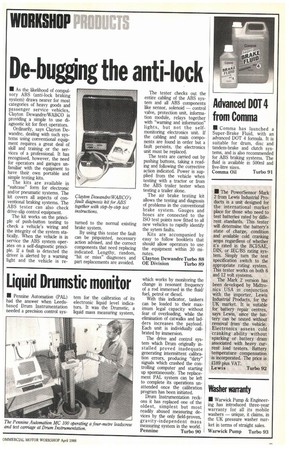ng the anti-lock
Page 129

If you've noticed an error in this article please click here to report it so we can fix it.
• As the likelihood of compulsory ABS (anti-lock braking system) draws nearer for most categories of heavy goods and passenger service vehicles, Clayton Dewandre/WABCO is providing a simple to use diagnostic kit for fleet operators.
Ordinarily, says Clayton Dewandre, dealing with such systems using conventional equipment requires a great deal of skill and training or the services of a professional. It has recognised, however, the need for operators and garages unfamiliar with the equipment to have their own portable and simple testing kits.
The kits are available in "suitcase" form for electronic and/or pneumatic systems. The kit covers all aspects of conventional braking systems. The ABS tester can also check drive-slip control equipment.
The kit works on the principle of push-button testing to check a vehicle's wiring and the integrity of the system statically. When the vehicle is in service the ABS system operates on a self-diagnostic principle. If a fault is detected the driver is alerted by a warning light and the vehicle is re turned to the normal existing brake system.
By using this tester the fault can be pinpointed, necessary action advised, and the correct components that need replacing indicated. Lengthy, random, "hit or miss" diagnoses and part replacements are avoided. The tester checks out the entire cabling of the ABS system and all ABS components like sensor, solenoid — control valve, protection unit, information module, relays together with "warning and information" lights, but not the selfmonitoring electronics unit. If the cabling and main components are found in order but a fault persists, the electronics unit must be replaced.
The tests are carried out by pushing buttons, taking a reading and following the corrective action indicated. Power is supplied from the vehicle when testing with a tractor or from the ABS trailer tester when testing a trailer alone.
The air brake testing kit allows the testing and diagnosis of problems in the conventional brake system. Gauges and hoses are connected to the ISO test points now fitted to all new vehicles to rapidly identify the sytem faults.
Kits are accompanied by easy to follow booklets that should allow operators to use the equipment within 30 minutes.
Clayton Dewandre Turbo 88 OE Division Turbo 89
















































































































































